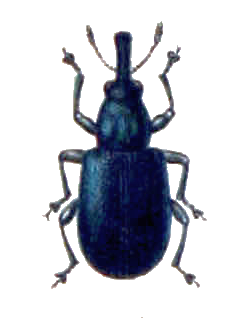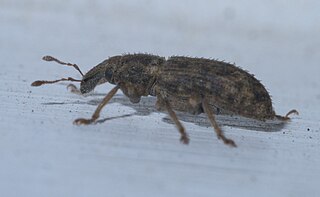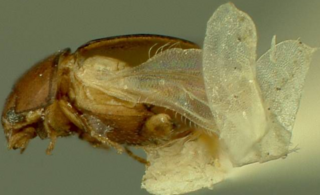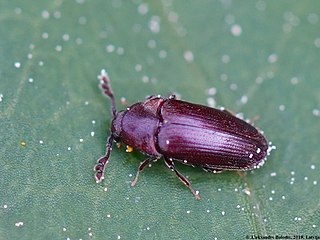
Corylophidae is a family of minute hooded beetles, sometimes called minute fungus beetles, in the superfamily Coccinelloidea. There are about 18 genera and at least 120 described species in Corylophidae. They feed on microfungi such as molds, and are often found associated with bark, as well as in leaf litter and other decaying vegetation. In older literature, the family name was often given as Orthoperidae.
Pachyschelus is a genus of metallic wood-boring beetles in the family Buprestidae. There are at least 270 described species in Pachyschelus.
Phyllophaga implicita is a species of May beetle or junebug in the family Scarabaeidae.
Neochodaeus is a genus of sand-loving scarab beetles in the family Ochodaeidae. There are at least four described species in Neochodaeus.
Chrysobothris rotundicollis is a species of metallic wood-boring beetle in the family Buprestidae. It is found in North America.

Auletobius is a genus of leaf and bud weevils in the family Attelabidae. There are at least 220 described species in Auletobius.

Listronotus is a genus of underwater weevils in the family Curculionidae. There are at least 100 described species in Listronotus.
Dialytellus dialytoides is a species of aphodiine dung beetle in the family Scarabaeidae. It is found in North America.

Teredidae is a family of beetles in the superfamily Coccinelloidea, formerly included within the family Bothrideridae. There are around 160 species in 10 genera, found worldwide except South America. Teredids are generally found under bark, in the galleries of wood-boring beetles, or in leaf litter. They are thought to be fungivores. The oldest records of the family are Delteredolaemus from mid-Cretaceous aged Burmese amber from Myanmar and a species of Teredolaemus from Eocene aged Baltic amber.

Murmidiidae is a family of beetles in the superfamily Coccinelloidea, formerly included within the family Cerylonidae. The family contains thirty-four described species in four genera, which are found worldwide. They are typically found under the bark of recently dead trees, and are thought to be mycophagous. The species Murmidius ovalis, found worldwide, is noted as a pest of stored food.

Anamorphidae is a family of beetles in the superfamily Coccinelloidea, formerly included within the family Endomychidae. They are found worldwide. Like enchomyids, they are fungivores, with adult and larval stages thought to exclusively consume fungal spores.

Mycetaeidae is a family of beetles in the superfamily Coccinelloidea, formerly included within the family Endomychidae. There are two genera currently included in the family, Agaricophilus and Mycetaea, which are morphologically divergent from each other, and it is unclear whether they are closely related. Mycetaea is found in North America, Europe and South Africa, while Agaricophilus is restricted to Europe. While the life history of Agaricophilus is obscure, Mycetaea is known to be mycophagous, feeding on molds.

Eupsilobiidae is a family of beetles in the superfamily Coccinelloidea, formerly included within the family Endomychidae. Most genera are restricted to the Neotropics, while the genus Eidoreus is found worldwide. They are fungivores, and have been observed living commensally in bee and ant nests.

Cybocephalidae is a family of sap, bark and fungus beetles in the order Coleoptera with a wide global distribution. The type genus Cybocephalus has more than 200 species in it and the entire family has about 220 species in all. Many species are predators of armoured scale insects (Diaspididae). There are four tarsal segments on all the legs. The body is only slightly longer than wide and very convex and shiny. They are small and about 1 to 3 mm long. The insect can roll into a ball like position with its downward facing head. The tarsomeres are lobed underneath. The family is sometimes treated as a subfamily within the Nitudulidae.

Limnichidae, commonly called minute marsh-loving beetles, is a family of beetles belonging to Byrrhoidea. There are at least 30 genera and 350 described species in Limnichidae. They are found worldwide, with the greatest diversity in tropical regions. Most species seem to be associated with water-adjacent habitats, such as riparian and coastal locations, though many species are likely fully terrestrial, with some species being associated with leaf litter and arboreal habitats. Species with known diets feed on moss or algae. The oldest fossils of the family are known from mid-Cretaceous Burmese amber from Myanmar.

Ptilodactylidae is a family of beetles belonging to the Elateriformia. There around 500 extant species in 35 genera. They are generally associated with riparian and aquatic habitats. The larvae generally live associated with rotting wood or vegetation, or within gravel and detritus on the edge of water bodies. The larvae of some species feed on submerged rotting wood or on plant roots, while the adults of some species are known to feed on fungus with modified brush-like maxillae.

Artematopodidae is a family of soft-bodied plant beetles in the superfamily Elateroidea. They are mostly found in understory forest foliage. The life history of the group is obscure, larvae of the genera Eurypogon and Macropogon likely feed on moss, while the larvae of Artematopus have been fed insect remains. The oldest fossils of the family date to the Middle Jurassic.

Throscidae is a family of elateroid beetles found worldwide with around 150 species in 5 extant genera. The larvae are soil-dwelling, siphoning fluid from mycorrhizae attached to trees. The adults are short-lived, with the adult males being noted for a complex mating dance. Like some other elateroids, they are capable of clicking.
Martinius is a genus of minute marsh-loving beetles in the family Limnichidae. There are at least three described species in Martinius.
Ctesibius is a genus of soft-bodied plant beetles in the family Artematopodidae. There is at least one described species in Ctesibius, C. eumolpoides.













